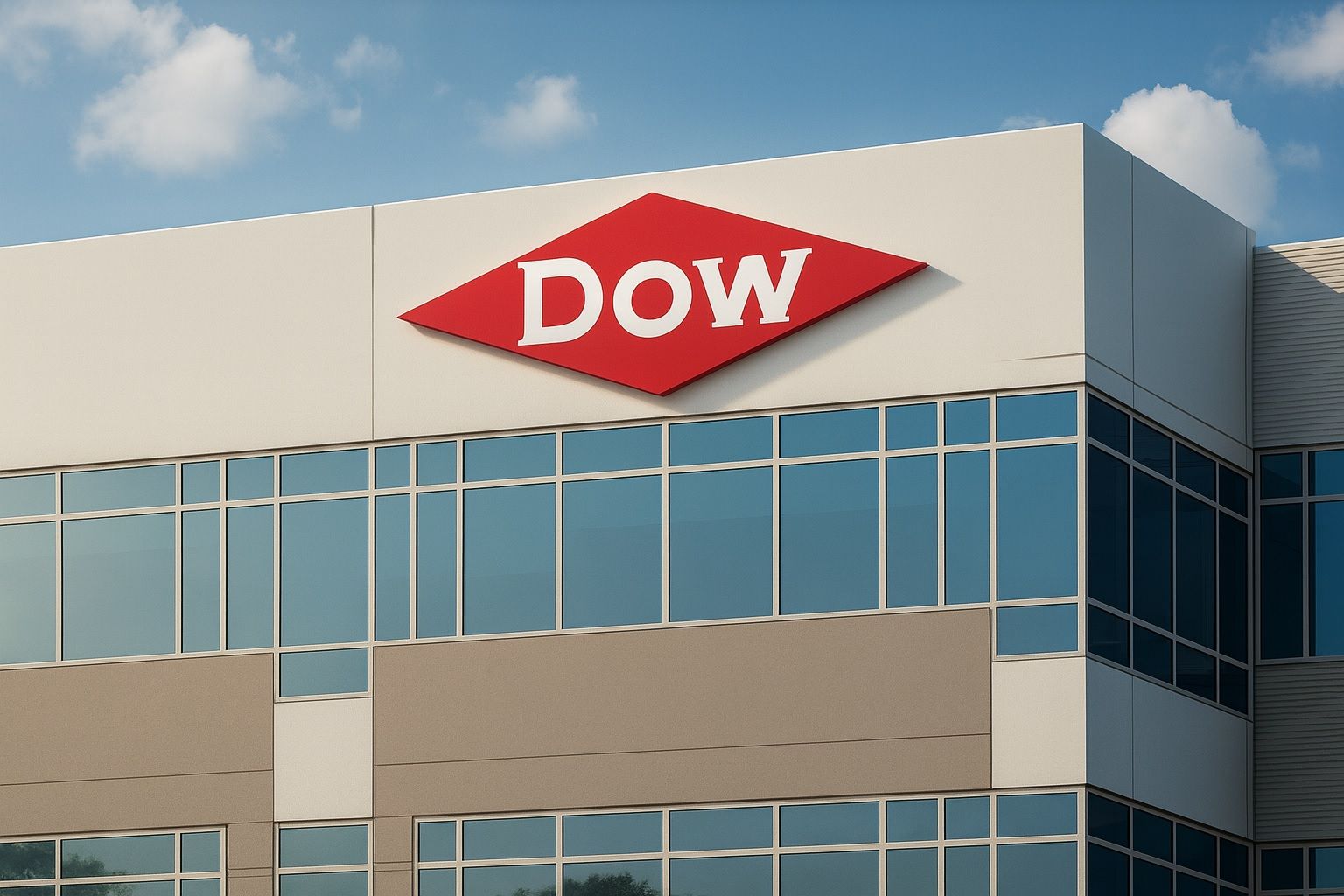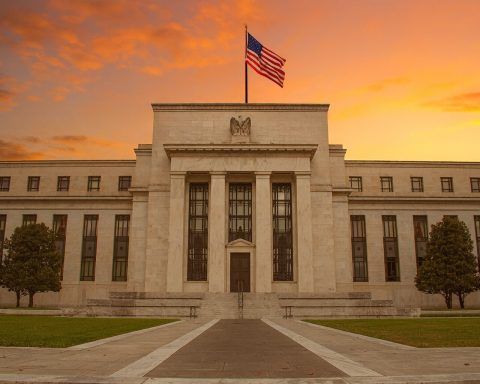Dow Inc. (NYSE: DOW) is back on traders’ radar this weekend after a sharp rebound in Friday’s session pushed the chemical giant’s share price to around $22.20, capping a volatile week for the stock and the broader materials sector. [1]
Dow Inc. (DOW) stock price today – 22 November 2025
- Last close (Friday, 21 Nov 2025): $22.20
- Daily move: +$1.25 (+5.97%)
- Trading volume: ~19.6 million shares, significantly above recent averages [2]
- Market cap: approx. $15.8 billion [3]
- Distance from 52‑week high: still about 50–52% below the peak near $46.35. [4]
Multiple real‑time data platforms — including Smartkarma, TradingView and Finviz — all show DOW up roughly 6% over the last 24 hours, hovering near $22.20 as of Saturday, 22 November 2025. [5]
Despite the bounce, Dow remains down roughly mid‑40% year‑to‑date, reflecting a difficult 2025 for commodity and specialty chemicals. [6]
What’s driving today’s move in Dow stock?
1. Technical rebound from a pivot bottom
Short‑term technical services are flagging Friday’s rally as a recovery from a recent pivot bottom:
- StockInvest notes that a buy signal from a pivot low on Thursday, 20 November 2025 has now produced a gain of about 5.97%, with rising volume confirming the move. [7]
- However, they still describe DOW’s broader trend as falling in the short term, with the long‑term moving average above the short‑term one — a technically cautious backdrop. [8]
In plain English: Friday’s jump looks more like a short‑term relief rally inside a downtrend than a confirmed long‑term trend reversal.
2. “Oversold but undervalued” narrative
Several market‑mover and trading‑oriented news sites published fresh coverage on 22 November highlighting Dow as:
- Down more than 44% year‑to‑date but
- Trading at low multiples of sales and book value (price‑to‑sales around 0.37 and price‑to‑book near 0.86). [9]
Timothy Sykes’ news desk, for example, describes Dow as a large‑scale chemicals player with about $42–43 billion in annual revenue, modest gross margins near 7%, negative net margins, but solid liquidity and a current ratio around 1.9. [10]
That mix — weak earnings, but strong balance‑sheet metrics and low valuation multiples — is feeding the “undervalued cyclical” storyline that often attracts contrarian buyers after a big drawdown.
3. Strong session in U.S. equities and materials
Friday’s move in DOW came alongside a generally positive day for U.S. equities, with the S&P 500 ending higher and several materials stocks posting solid gains. [11]
Sector‑level flows appear to have helped Dow’s rally, amplifying stock‑specific technical momentum.
Fundamentals: Q2–Q3 2025 results show pressure, but cash flow is improving
Dow’s latest quarterly numbers help explain why the stock has struggled in 2025 — and why some investors are cautiously optimistic after Q3.
Second quarter 2025 (reported 24 July 2025)
From Dow’s Q2 2025 earnings release: [12]
- Net sales: $10.1 billion, down 7% year‑over‑year, with declines across all operating segments.
- Segment trends:
- Packaging & Specialty Plastics: ~$5.0B sales, pressured by lower polymer prices.
- Industrial Intermediates & Infrastructure: ~$2.8B, down 6% YoY.
- Performance Materials & Coatings: ~$2.1B, down 5% YoY.
- Profitability was hit by lower prices and weaker demand, especially in Europe and construction‑related markets.
Those results, combined with macro headwinds, set the stage for a dividend cut (more on that below) and contributed to the stock’s steep decline during mid‑2025. [13]
Third quarter 2025 (reported 23 October 2025)
Q3 numbers showed some stabilization and improving cash flow, even though earnings remained weak:
- Net sales: $10.0 billion, down 8% year‑over‑year and 1% sequentially. [14]
- GAAP net income: $124 million.
- Operating EPS:–$0.19, better than the –$0.42 loss in Q2. [15]
- Cash from operating activities (continuing ops): $1.1 billion, up $330 million YoY and up $1.6 billion sequentially, thanks largely to working‑capital improvements and advance payments tied to low‑carbon solutions and other long‑term contracts. [16]
Dow also reiterated progress on a $6.5 billion near‑term “cash support” program, including:
- ~$1 billion in capital spending cuts
- Accelerated delivery of $1 billion in cost reductions by end‑2026 [17]
Reuters noted that these cost cuts and new Gulf Coast capacity helped Dow beat expectations for its Q3 adjusted loss, sending shares up double‑digits on the day of the report, even as management warned of continued pricing and demand headwinds into Q4. [18]
Dividend after the 2025 cut: still high, but under scrutiny
From 70 cents to 35 cents per share
Dow’s income story changed dramatically in mid‑2025. A September 2025 class‑action notice recaps that the company cut its quarterly dividend in half, from $0.70 to $0.35 per share, alongside weaker‑than‑expected Q2 results and ongoing macro pressure. [19]
In October, Dow’s board reaffirmed the new $0.35 quarterly dividend, payable on 12 December 2025 to shareholders of record on 28 November 2025. The company highlighted that this payment will represent the 457th consecutive dividend paid by Dow or its affiliates since 1912 — an important signal to income‑oriented investors. [20]
Implied yield at today’s price
At a share price around $22.20, the new annualized dividend of $1.40 per share implies a yield of roughly 6.3%. That’s high by large‑cap standards, but it reflects both:
- Dow’s desire to preserve an income profile, and
- The market’s skepticism after a cut and a sharp share‑price decline.
Earlier in 2025, Yahoo Finance highlighted a “major legal victory in Canada” that removed an environmental liability overhang and was seen as supportive for long‑term dividend capacity. [21]
Still, with net margins negative and a large cost‑cut program underway, investors are likely to closely watch future earnings and free cash flow to judge how sustainable even the reduced payout is.
Analyst ratings and price targets: “Hold” with modest upside
Fresh analyst‑rating data this week adds nuance to DOW’s rally.
Citigroup trims target, keeps Neutral
On 19 November 2025, Citigroup:
- Lowered its price target on DOW to $23 from $25
- Maintained a “Neutral” rating
GuruFocus’ summary of the note lists a wide range of Street targets:
- Average 12‑month target: $27.70
- High estimate: $43.52
- Low estimate: $20.00
- Implied upside vs. recent price (~$21.5 at the time of the report) of about 28.5%. [22]
Earlier October updates
Citigroup’s move follows a cluster of revisions in late October:
- Goldman Sachs: Neutral; target raised from $24 to $27
- RBC Capital: Sector Perform; target raised from $24 to $27
- UBS: Neutral; target lifted from $24 to $25
- J.P. Morgan and Mizuho: maintained Neutral ratings while trimming targets to the low‑mid $20s. [23]
Across these notes, the message is consistent: DOW is broadly rated “Hold,” not an outright favorite, but screens as potentially undervalued if management can deliver on cost cuts, cash‑flow targets and growth projects.
Zacks currently reports a trailing P/E around 300+, a mathematically high figure largely driven by depressed earnings — another reason many analysts focus on cash flow and normalized cycle earnings, rather than near‑term EPS. [24]
Today’s news themes: AI, sustainability and speculative price forecasts
Newsflow dated 22 November 2025 around DOW clusters into three main storylines.
1. AI infrastructure and digital transformation
Two detailed pieces from the Timothy Sykes / Millionaire Media network — “Dow’s Advancements Bolster AI Ecosystem and Market Standing” and “Dow’s Material Innovation Drives Sustainability in AI Ecosystems” — emphasize: [25]
- A strategic collaboration with Kyndryl to embed AI and automation in Dow’s technology infrastructure, aimed at improving efficiency and competitiveness.
- The role of Dow’s materials in supporting AI data‑center ecosystems, such as advanced insulation, cooling and specialty polymers.
- Environmental projects like the Qingyi River conservation initiative, used as examples of Dow’s sustainability branding.
These articles frame Dow as leaning into AI‑adjacent demand and “green” credentials, even while core commodity chemicals remain under pricing pressure.
2. Cautious optimism from trading and technical sites
- Smartkarma’s Market Movers note headline that “Dow Inc.’s stock price skyrockets to $22.20, marking a bullish 5.97% surge”*, but also points out that the stock is still down more than 44% year‑to‑date, with heavy trading volume as bargain‑hunters step in. [26]
- StockInvest describes Friday’s move as a short‑term buy signal from a pivot bottom, but expects that, within the existing downtrend, the stock might still trade in roughly a $17.8–$22.8 range over the next three months. [27]
Overall tone: bullish short‑term, cautious medium‑term.
3. Aggressive long‑term price predictions (handle with care)
Crypto‑style analytics site Hexn publishes algorithmic forecasts suggesting DOW could trade: [28]
- Between about $23.9 and $35.9 in 2026 (average ~$29.5)
- Rising to much higher hypothetical ranges in 2027–2031
These figures are not Wall Street consensus and are generated via technical/quantitative models; they should be treated as speculative projections, not as fundamental valuations.
Legal overhang: securities‑fraud class actions linked to the dividend cut
On 22 September 2025, law firm Glancy Prongay & Murray LLP announced a class‑action lawsuit on behalf of investors who bought DOW shares between 30 January and 23 July 2025. [29]
The complaint alleges that Dow and certain executives:
- Overstated the company’s ability to handle macro and tariff headwinds while supporting its “lucrative dividend,” and
- Understated the severity of weakening demand, pricing pressure and oversupply in key markets. [30]
The suit points specifically to:
- A BMO downgrade on 23 June 2025, citing pressure on the dividend and end markets, and
- The July 24, 2025 Q2 release, where Dow reported a larger‑than‑expected loss and announced the dividend cut, which triggered sharp single‑day share‑price declines. [31]
Additional investor‑rights firms have issued similar “deadline alert” notices, adding to headline risk around the stock even as management focuses on cost‑cutting and growth projects.
How solid is the balance sheet?
Current third‑party analyses of Dow’s financial profile paint a picture of a leveraged but not distressed balance sheet: [32]
- Total assets: around $61 billion
- Liabilities: roughly $41 billion
- Debt‑to‑equity: about 1.1x
- Quick ratio: ~1.0; current ratio: ~1.9
- Operating cash flow: over $1.1 billion in Q3 alone
These metrics support Dow’s strategy of:
- Funding growth projects in higher‑margin specialty and sustainability‑linked markets,
- Maintaining a (reduced) dividend, and
- Absorbing cyclical downturns in commodity chemicals.
However, the combination of negative net margins and ongoing capex means management has limited room for error if global demand slows further or if pricing pressure worsens.
Key dates and catalysts to watch
Looking ahead from 22 November 2025, investors tracking DOW will be watching:
- Next earnings report: Dow is expected to release its next quarterly earnings on 29 January 2026, according to Zacks’ earnings calendar. [33]
- Dividend record and payment dates:
- Record date for the current $0.35 dividend: 28 November 2025
- Payment date: 12 December 2025 [34]
- Progress on the $6.5B cash‑support and cost‑reduction plan, including further updates on European asset reviews and Gulf Coast capacity ramps. [35]
- Developments in securities‑fraud lawsuits, which could influence sentiment even if the ultimate financial impact ends up modest. [36]
Bottom line for 22 November 2025
- Price action: DOW’s nearly 6% jump to about $22.20 reflects a technical bounce from oversold levels, aided by strong volume and a firmer broader market. [37]
- Fundamentals: Q3 numbers confirm ongoing pressure on sales and margins, but also demonstrate improving cash flow and meaningful progress on cost cuts and capital discipline. [38]
- Income story: After a 2025 cut, the dividend still yields around 6%, making Dow attractive to yield seekers who are comfortable with cyclical risk. [39]
- Risk/Reward: Analysts mostly rate DOW as “Hold”, with moderate upside to consensus targets but significant execution, macro and legal risks. [40]
For now, today’s news flow paints Dow Inc. as a high‑yield, cyclical turnaround story: technically bouncing, fundamentally still in repair mode, and heavily dependent on management’s ability to navigate weak chemical markets while delivering on cost cuts and growth in AI‑ and sustainability‑linked applications.
This article is for informational purposes only and does not constitute investment advice or a recommendation to buy or sell any security.
References
1. finviz.com, 2. finviz.com, 3. hexn.io, 4. www.marketwatch.com, 5. www.smartkarma.com, 6. www.timothysykes.com, 7. stockinvest.us, 8. stockinvest.us, 9. www.timothysykes.com, 10. www.timothysykes.com, 11. www.investopedia.com, 12. www.prnewswire.com, 13. www.prnewswire.com, 14. www.prnewswire.com, 15. www.prnewswire.com, 16. www.prnewswire.com, 17. www.prnewswire.com, 18. www.reuters.com, 19. www.globenewswire.com, 20. investors.dow.com, 21. finance.yahoo.com, 22. www.gurufocus.com, 23. www.gurufocus.com, 24. www.zacks.com, 25. www.timothysykes.com, 26. www.smartkarma.com, 27. stockinvest.us, 28. hexn.io, 29. www.globenewswire.com, 30. www.globenewswire.com, 31. www.globenewswire.com, 32. www.timothysykes.com, 33. www.zacks.com, 34. investors.dow.com, 35. www.prnewswire.com, 36. www.globenewswire.com, 37. stockinvest.us, 38. www.prnewswire.com, 39. investors.dow.com, 40. www.gurufocus.com







